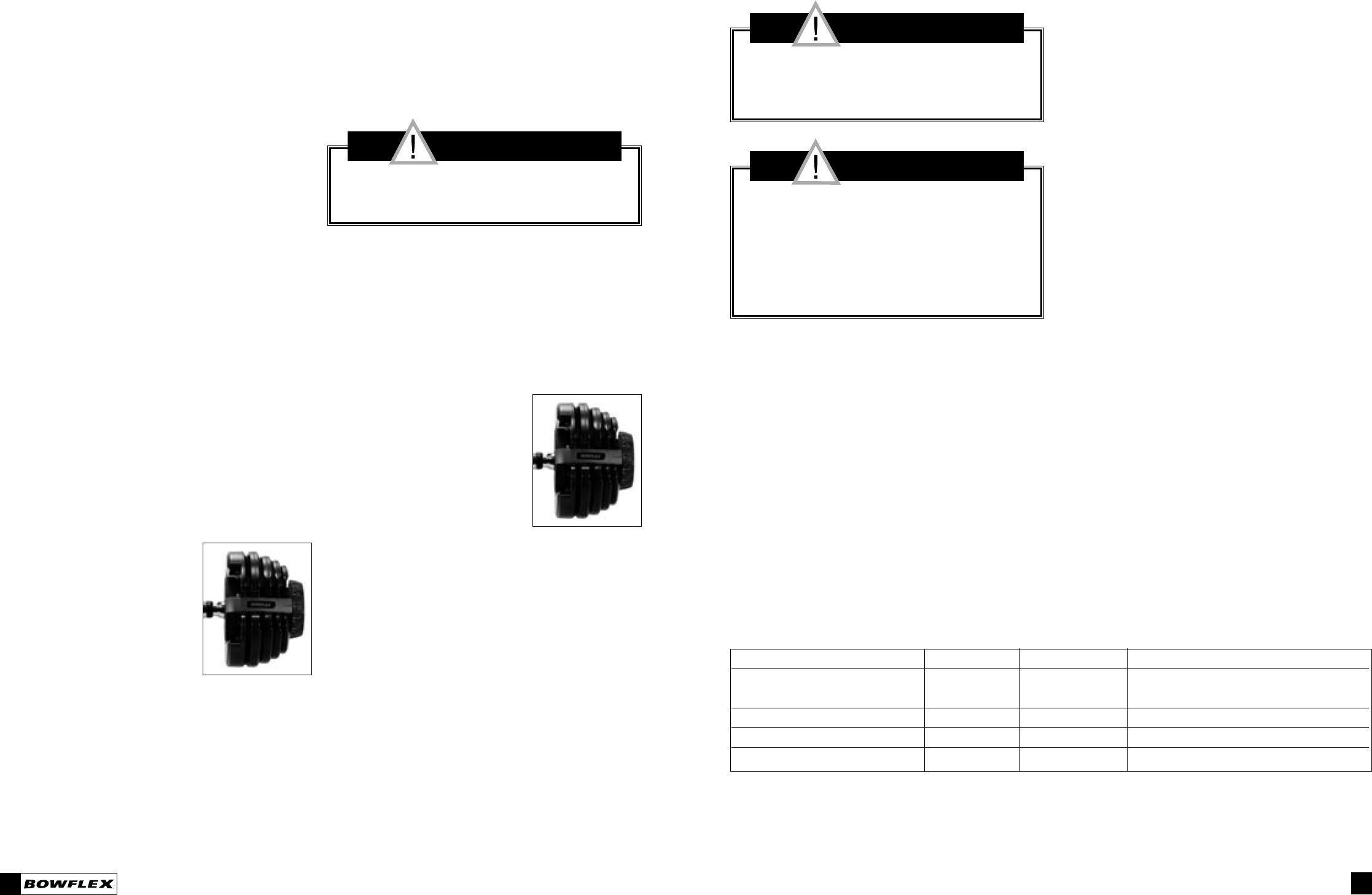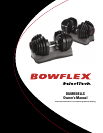
4
5
Understanding and testing the locking
mechanism function
The Bowflex
®
SelectTech™ Dumbbell features a patent
pending locking mechanism designed to assure proper and
complete selection of the weight plates as well as to ensure
weight plate retention during the workout. It is important
that you fully understand the function of this mechanism
and periodically test it to ensure it is properly functioning.
Function
The locking mechanism provides two key functions:
1. The mechanism will only allow the adjustment knobs
to be rotated when the dumbbell handle is complete-
ly inserted and engaging the dumbbell base.
2. The mechanism is designed to lock the dumbbell
handle to the base if either adjustment knob is not
fully engaging the selected weight plates.
Purpose
The locking mechanism serves two important purposes:
1. The mechanism will prevent deselecting (dropping)
weight plates from the dumbbell when it is NOT in
the dumbbell base.
2. The mechanism will prevent partial selection of
the weight plates in which the plates are not fully
supported and the locking pin is not fully engaged.
Given the importance of this locking mechanism, it is
critical that you understand how it operates and how to
periodically test it to make sure it is functioning correctly.
Testing proper locking mechanism function
1. With the dumbbell handle set
in the dumbbell base, turn
both adjustment knobs to
the number 5. You will know
you have fully and correctly
selected the number when
you feel the adjustment knob
settle into a notch (known as
a detent). You will also hear
a slight, but audible, clicking
noise that corresponds with the detent locations for
each number.
2. You should be able to withdraw the handle from the
base leaving all the weight plates behind.
3. With the handle removed from the base, grab one
adjustment knob with your other hand and gently
attempt to turn the knob, the knob should not rotate.
A locking pin in the mechanism will have engaged
the rotational assembly when the unit was withdrawn
from the base. Perform this test with all adjustment
knobs.
Do not use a great deal of force in an attempt to turn
the locked adjustment knob. Excessive force may
damage the locking mechanism.
4. After confirming the proper function of the lock-
ing mechanism as described above, return and
fully insert the dumbbell handle back into the base
assembly.
5. With the handle back in the base, turn the adjustment
knob on one side to a position that is in-between the
5 and 7.5 number. This represents an incomplete
weight selection where the adjustment knob has not
fully selected a weight and the knob is in-between the
selection detents (clicks).
6. With the selection knob in
this improper position, gently
attempt to lift up on the handle
to remove it from the base. You
should find that the handle is
locked to the base and cannot
be removed with light pressure
as it can normally.
7. Return the improperly selected
adjustment knob to a full and
proper weight selection and assure that the dumbbell
handle can once again be removed.
8. Repeat this test for all adjustment knobs.
9. Assure the entire dumbbell handle assembly is
properly tightened. Do this by setting the adjust-
ment knobs to five pounds and removing the handle
assembly from the base. Grab both adjustment knobs
and very slightly push and pull the knobs toward and
away from the handle grip. The knobs should not
exhibit free play and all of the selection discs should
feel tightly connected.
10. You have now tested the function of the locking
mechanism. We suggest you repeat this test periodi-
cally (once a month) to confirm the proper function
of the locking mechanism.
Do not intentionally engage the locking mechanism
and attempt to lift the entire dumbbell via the grip.
The dumbbell should only be lifted by using the lift
handles molded into the base assembly.
If the dumbbell locking mechanism fails to perform
in accordance with the test procedure above,
do the following things:
1. Discontinue use of the product immediately
until proper service can be provided.
2. Contact your Bowflex retailer or contact
Bowflex directly by phone
at 1-800-605-3369 for service.
Offset weight selection
As indicated above, proper selection for a given weight
is accomplished by selecting that weight number on both
ends of the dumbbell. For example: to select 20 lbs, one
must dial both adjustment knobs on the dumbbell to the
number 20. By selecting the same number on both sides of
the dumbbell, you will replicate a common dumbbell, this
is to say, a balanced dumbbell with equal weight on both
sides. While this is the most common form of weight selec-
tion and will be used in the vast majority of workouts, the
Bowflex SelectTech™ Dumbbell offers a useful and unique
workout alternative known as offset weight selection. Offset
weight selection involves using a different weight setting
on one side of the dumbbell relative to the other. Doing so
can be a powerful muscle development tool during certain
workouts, such as the biceps curl. The SelectTech Dumbbell
functions exactly the same way whether you have selected
balanced or offset weights. The only exception is that when
you are using offset weights, you must return the dumbbell
to the base in the same orientation that you removed it.
When you have offset weight selection the combination of
weight plates selected will not be the same on both sides of
the dumbbell. You must therefore make certain to return the
dumbbell to the base in the same orientation in which it was
removed, in order for the weight plates to settle back into
the corresponding vacant slots in the dumbbell base.
Example of offset weight selection workout
Performed traditionally, dumbbell curls strengthen the
biceps, but do little for the forearm muscles that assist
in supination and pronation of the wrist. Supination and
pronation are terms describing a rotating motion of the
wrist. For example, turning a doorknob and turning your
key in your car’s ignition are examples of supination and
pronation. Turning a doorknob clockwise would be the
supination direction, while counter-clockwise would be the
pronation direction. Whether you are training for a specific
sport, or just training to become stronger and improve activ-
ities of daily living, training your forearm muscles that are
involved in supination and pronation can be beneficial.
These dumbbells allow you to train differently than
traditional dumbbells. By using different weight settings on
either side of the dumbbells, you can use those supination/
pronation muscles during your curls. Using more weight
on the thumb side of the dumbbell will improve pronation
strength, while more weight on the little finger side will
improve supination strength. Not only will you be strength-
ening your biceps, but also you can become stronger in
activities involving rotation of the wrist!
The following example of a Biceps Curl using offset weight
is a good demonstration of the superior muscle development
provided by the SelectTech Dumbbell.
WARNING
DANGER
Side 1 Side 2 Total dumbbell weight
Weight settings selected 20lbs 30 lbs 25 lbs
Weight Difference Δ 10 lbs
Weight Distribution 10 lbs 15 lbs 25 lbs
Weight offset + 5 lbs
WARNING


















